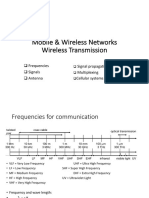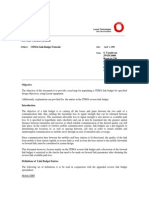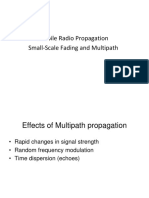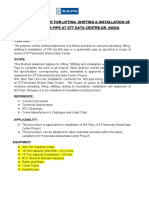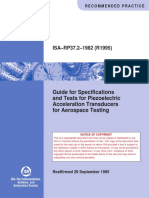Modulation Techniques and Demodulation
Uploaded by
Mahmoud ElbaroudyModulation Techniques and Demodulation
Uploaded by
Mahmoud ElbaroudyEC744 Wireless Communication
EC744 Wireless Communication
Fall 2008
Fall 2008
Mohamed Essam Khedr
Department of Electronics and Communications
Wireless Communication Fading
Modulation
Syllabus
Syllabus
Tentatively
Channel coding techniques
Week 6
Mid Term exam (take home), Diversity techniques
Week 7
Equalization techniques
Week 8
Spread spectrum, MIMO and OFDM
Week 9
Wireless networking: 802.11, 802.16, UWB
Week 10
Hot topics
Week 11
Presentations
Week 12
Presentations
Week 13
Final Exam
Week 15
Presentations
Week 14
Source coding techniques
Week 5
Modulation techniques
Demodulation techniques (coherent and non-coherent)
Week 4
Channel characteristics (AWGN, fading)
Week 3
Digital Communication fundamentals
Week 2
Overview wireless communications, Probabilities
Week 1
What is modulation
What is modulation
Modulation is the process of encoding information from a
message source in a manner suitable for transmission
It involves translating a baseband message signal to a bandpass
signal at frequencies that are very high compared to the
baseband frequency.
Baseband signal is called modulating signal
Bandpass signal is called modulated signal
Baseband and Carrier Communication
Baseband and Carrier Communication
Baseband:
Describes signals and systems whose range of frequencies is measured
from 0 to a maximum bandwidth or highest signal frequency
Voice: Telephone 0-3.5KHz; CD 0-22.05KHz
Video: Analog TV 4.5MHz, TV channel is 0-6MHz. Digital, depending
on the size, movement, frames per second,
Example: wire, coaxial cable, optical fiber, PCM phone
Carrier Communication:
Carrier: a waveform (usually sinusoidal) that is modulated to represent
the information to be transmitted. This carrier wave is usually of much
higher frequency than the modulating (baseband) signal.
Modulation: is the process of varying a carrier signal in order to use
that signal to convey information.
.
Modulation Techniques
Modulation Techniques
Modulation can be done by varying the
Amplitude
Phase, or
Frequency
of a high frequency carrier in accordance with the amplitude of the
message signal.
Demodulation is the inverse operation: extracting the baseband
message from the carrier so that it may be processed at the
receiver.
Goal of Modulation Techniques
Goal of Modulation Techniques
Modulation is difficult task given the hostile mobile radio
channels
Smcll-sccle [cdinq cnd multipcth conditions.
The goal of a modulation scheme is:
Transport the message signal through the radio channel with best
possible quality
Occupy least amount of radio (RF) spectrum.
Frequency versus Amplitude Modulation
Frequency versus Amplitude Modulation
Amplitude Modulation (AM)
Changes the amplitude of the carrier signal according to the amplitude of
the message signal
All info is carried in the amplitude of the carrier
There is a linear relationship between the received signal quality and
received signal power.
AM systems usually occupy less bandwidth then FM systems.
AM carrier signal has time-varying envelope.
AM Broadcasting
AM Broadcasting
History
Frequency
Long wave: 153-270kHz
Medium wave: 520-1,710kHz, AM radio
Short wave: 2,300-26,100kHz, long distance, SSB, VOA
Limitation
Susceptibility to atmospheric interference
Lower-fidelity sound, news and talk radio
Vestigial Sideband (VSB)
Vestigial Sideband (VSB)
VSB is a compromise between DSB and SSB. To produce SSB signal from
DSB signal ideal filters should be used to split the spectrum in the middle so
that the bandwidth of bandpass signal is reduced by one half. In VSB system
one sideband and a vestige of other sideband are transmitted together. The
resulting signal has a bandwidth > the bandwidth of the modulating
(baseband) signal but < the DSB signal bandwidth.
c
c
SSB (Upper sideband)
0
0
c
c
) (
SSB
VSB Spectrum
c
) (
VSB
c
DSB
QAM
QAM
AM signal BANDWIDTH : AM signal bandwidth is twice the bandwidth
of the modulating signal. A 5kHz signal requires 10kHz bandwidth for AM
transmission. If the carrier frequency is 1000 kHz, the AM signal spectrum
is in the frequency range of 995kHz to 1005 kHz.
QUADRARTURE AMPLITUDE MODULATION is a scheme that allows
two signals to be transmitted over the same frequency range.
Equations
Coherent in frequency
and phase. Expensive
TV for analog
Most modems
Angle Modulation
Angle Modulation
Angle of the carrier is varied according to the amplitude of the
modulating baseband signal.
Two classes of angle modulation techniques:
Frequency Modulation
Instantaneous frequency of the carrier signal is varied linearly
with message signal m(t)
Phase Modulation
The phase (t) of the carrier signal is varied linearly with the
message signal m(t).
Angle Modulation
Angle Modulation
+ = + =
t
f c c c c FM
dx x m k t f A t t f A t s ) ( 2 2 cos )] ( 2 cos( ) (
k
f
is the frequency deviation constant (kHz/V)
If modulation signal is a sinusoid of amplitude A
m
, frequency f
m
:
)] 2 sin( 2 cos( ) ( t f
f
A k
t f A t s
m
m
m f
c c FM
+ =
[ ] ) ( 2 cos ) ( t m k t f A t s
c c PM
+ =
k
is the phase deviation constant
PHASE MODULATION
FREQUENCY MODULATION
FM Example
FM Example
- + - -
[ ]
) 8 2 cos(
) 2 sin( 4 8 2 cos ) (
) 2 cos( 4 ) (
t
t t t s
t t m
+ =
= Message signal
FM Signal
Carrier Signal
0
-4
4
1 0.5
1.5
+
2
TV broadcasting
TV broadcasting
fm=15KHz, f=25KHz, =5/3, B=2(fm+f)=80kHz
Center fc+4.5MHz
Comparison of modulation systems
Comparison of modulation systems
Satellite Radio
Satellite Radio
WorldSpace outside US, XM Radio and Sirius in North America
3 Loral satellites at high-
elevation geosynchronous orbit
2 Boeing geostationary
satellites
Satellite
165+, 80+streams of music 170+, 90+streams of music Total channel
12.95/month 12.95/month Monthly rate
4,000,000+ 7,000,000+ Current Subscribers
SIRI, $5 billion, NYC XMSR, $2billion, DC Company info
Sirius XM Satellite Radio
Geometric Representation of Modulation Signal
Geometric Representation of Modulation Signal
Digital Modulation involves
Choosing a particular signal waveform for transmission for a
particular symbol or signal
For M possible signals, the set of all signal waveforms are:
For binary modulation, each bit is mapped to a signal from a set
of signal set S that has two signals
We can view the elements of S as points in vector space
)} ( ),..., ( ), ( {
2 1
t s t s t s S
M
=
Geometric Representation of Modulation Signal
Geometric Representation of Modulation Signal
Vector space
We can represented the elements of S as linear combination of
basis signals.
The number of basis signals are the dimension of the vector space.
Basis signals are orthogonal to each-other.
Each basis is normalized to have unit energy:
signal. basis the is ) (
1 ) (
2
th
i
i
i t
dt t E
= =
0 ) ( ) (
) ( ) (
1
=
=
=
dt t t
t s t s
j i
N
j
j ij i
Example
Example
{ } ) ( ), (
) 2 cos(
2
) (
) 2 cos(
2
) (
) 2 cos(
2
) (
1 1
1
2
1
t E t E S
t f
T
t
t f
T
E
t s
t f
T
E
t s
b b
c
b
c
b
b
c
b
b
=
=
=
=
b
b
T t 0
T t 0
b
E
b
E
Q
I
The basis signal
Two signal
waveforms to
be used for
transmission
Constellation Diagram
Dimension = 1
Constellation Diagram
Constellation Diagram
Properties of Modulation Scheme can be inferred from
Constellation Diagram
Bandwidth occupied by the modulation increases as the dimension
of the modulated signal increases
Bandwidth occupied by the modulation decreases as the signal
points per dimension increases (getting more dense)
Probability of bit error is proportional to the distance between the
closest points in the constellation.
it error decrecses cs the distcnce increcses (spcrse).
Concept of a constellation diagram
Concept of a constellation diagram
Linear Modulation Techniques
Linear Modulation Techniques
Classify digital modulation techniques as:
Linear
The cmplitude o[ the trcnsmitted siqncl tcries linecrlu uith
the modulctinq diqitcl siqncl, m(t).
Theu usucllu do not hcte constcnt entelope.
More spectrcl e[[icient.
Poor pouer e[[iciencu
Excmple: PSK, DPSK.
Non-linear
Binary Phase Shift Keying
Binary Phase Shift Keying
Use alternative sine wave phase to encode bits
Phases are separated by 180 degrees.
Simple to implement, inefficient use of bandwidth.
Very robust, used extensively in satellite communication.
Q
0
State
1
State
0 binary
1 binary
) 2 cos( ) (
) 2 cos( ) (
2
1
+ + =
+ =
c c c
c c c
f A t s
f A t s
BPSK Example
BPSK Example
Data
Carrier
Carrier+
BPSK waveform
1 1 0 1 0 1
BPSK Virtue of pulse shaping
BPSK Virtue of pulse shaping
BPSK Coherent demodulator
BPSK Coherent demodulator
Differential PSK encoding
Differential PSK encoding
Differential BPSK
0 = same phase as last signal element
1 = 180 shift from last signal element
EE 552/452 Spring 2007
DPSK modulation and demodulation
DPSK modulation and demodulation
3dB loss
Quadrature
Quadrature
Phase Shift Keying
Phase Shift Keying
Multilevel Modulation Technique: 2 bits per symbol
More spectrally efficient, more complex receiver.
Two times more bandwidth efficient than BPSK
Q
11 State
00 State
10 State
01 State
Phase of Carrier: /4, 2/4, 5/4, 7/4
( )
= t s
|
.
|
\
|
+
4
2 cos
t f A
c
11
|
.
|
\
|
+
4
3
2 cos
t f A
c
|
.
|
\
|
4
3
2 cos
t f A
c
|
.
|
\
|
4
2 cos
t f A
c
01
00
10
4 different waveforms
4 different waveforms
-1.5
-1
-0.5
0
0.5
1
1.5
0 0.2 0.4 0.6 0.8 1
-1.5
-1
-0.5
0
0.5
1
1.5
0 0.2 0.4 0.6 0.8 1
-1.5
-1
-0.5
0
0.5
1
1.5
0 0.2 0.4 0.6 0.8 1
-1.5
-1
-0.5
0
0.5
1
1.5
0 0.2 0.4 0.6 0.8 1
11
01
00
10
cos+sin
-cos+sin
cos-sin -cos-sin
QPSK Example
QPSK Example
QPSK Virtue of pulse shaping
QPSK Virtue of pulse shaping
QPSK modulation
QPSK modulation
QPSK receiver
QPSK receiver
Differential Coherent
Differential Coherent
DBPSK
3dB loss
QPSK BER, the same as BPSK
Offset QPSK waveforms
Offset QPSK waveforms
Offset OQPSK
Offset OQPSK
QPSK can have 180 degree jump, amplitude fluctuation
By offsetting the timing of the odd and even bits by one bit-period, or half a
symbol-period, the in-phase and quadrature components will never change at
the same time.
90 degree jump
Pi/4 QPSK signaling
Pi/4 QPSK signaling
135 degree
Non-coherent
detection
Pi/4 QPSK transmitter
Pi/4 QPSK transmitter
I. Differential detection of pi/4 QPSK
I. Differential detection of pi/4 QPSK
III. FM Discriminator detector
III. FM Discriminator detector
Constant Envelope Modulation
Constant Envelope Modulation
Amplitude of the carrier is constant, regardless of the
variation in the modulating signal
Better immunity to fluctuations due to fading.
Better random noise immunity
Power efficient
They occupy larger bandwidth
Frequency Shift Keying (FSK)
Frequency Shift Keying (FSK)
The frequency of the carrier is changed according to the
message state (high (1) or low (0)).
One frequency encodes a 0 while another frequency encodes a 1
(a form of frequency modulation)
0) (bit T t 0
1) (bit T t 0
b
b
= =
= + =
t f f A t s
t f f A t s
c
c
) 2 2 cos( ) (
) 2 2 cos( ) (
2
1
Continues FSK
) ) ( 2 2 cos( ) (
)) ( 2 cos( ) (
+ =
+ =
t
f c
c
dx x m k t f A t s
t f A t s
Integral of m(x) is continues.
FSK Bandwidth
FSK Bandwidth
Limiting factor: Physical capabilities of the carrier
Not susceptible to noise as much as ASK
Applications
On voice-grade lines, used up to 1200bps
Used for high-frequency (3 to 30 MHz) radio transmission
used at higher frequencies on LANs that use coaxial cable
Multiple Frequency
Multiple Frequency
-
-
Shift Keying (MFSK)
Shift Keying (MFSK)
More than two frequencies are used
More bandwidth efficient but more susceptible to error
f
i
= f
c
+ (2i 1 M)f
d
f
c
= the carrier frequency
f
d
= the difference frequency
M = number of different signal elements = 2
L
L = number of bits per signal element
( ) t f A t s
i i
2 cos =
M i 1
FSK Coherent Detection
FSK Coherent Detection
Noncoherent
Noncoherent
FSK
FSK
MSK modulation
MSK modulation
MSK reception
MSK reception
Minimum Shift Keying spectra
Minimum Shift Keying spectra
GMSK spectral shaping
GMSK spectral shaping
EE 552/452 Spring 2007
Simple GMSK modulation and demodulation
Simple GMSK modulation and demodulation
Pulse Shaped M
Pulse Shaped M
-
-
PSK
PSK
QAM
QAM
Quadrature
Quadrature
Amplitude Modulation
Amplitude Modulation
Modulation technique used in the cable/video networking world
Instead of a single signal change representing only 1 bps
multiple bits can be represented buy a single signal change
Combination of phase shifting and amplitude shifting (8 phases, 2
amplitudes)
QAM
QAM
QAM
As an example of QAM, 12
different phases are combined
with two different amplitudes
Since only 4 phase angles have 2
different amplitudes, there are a
total of 16 combinations
With 16 signal combinations, each
baud equals 4 bits of information
(2 ^ 4 = 16)
Combine ASK and PSK such that
each signal corresponds to
multiple bits
More phases than amplitudes
Minimum bandwidth requirement
same as ASK or PSK
16
16
-
-
QAM Signal Constellation
QAM Signal Constellation
QAM vs. MFSK
QAM vs. MFSK
Comparison of Digital Modulation
Comparison of Digital Modulation
Modulation Summary
Modulation Summary
Phase Shift Keying is often used, as it provides a highly
bandwidth efficient modulation scheme.
QPSK, modulation is very robust, but requires some form of
linear amplification. OQPSK and p/4-QPSK can be
implemented, and reduce the envelope variations of the signal.
High level M-ary schemes (such as 64-QAM) are very
bandwidth efficient, but more susceptible to noise and require
linear amplification.
Constant envelope schemes (such as GMSK) can be employed
since an efficient, non-linear amplifier can be used.
Coherent reception provides better performance than
differential, but requires a more complex receiver.
You might also like
- Refutation of - Some Observations, - by Frithjof Schuon - Criticizing René Guénon - Pages 16 To The End.No ratings yetRefutation of - Some Observations, - by Frithjof Schuon - Criticizing René Guénon - Pages 16 To The End.42 pages
- Latinos and The Nation's Future Edited by Henry G. Cisneros and John Rosales100% (2)Latinos and The Nation's Future Edited by Henry G. Cisneros and John Rosales273 pages
- Canon - Elura 10A, 20MCA - Service ManualNo ratings yetCanon - Elura 10A, 20MCA - Service Manual177 pages
- Presentation On Digital Modulation and Forward Error Correction100% (1)Presentation On Digital Modulation and Forward Error Correction74 pages
- Modulacion-Demodulacion-Medios de Transmision y Normatividad100% (2)Modulacion-Demodulacion-Medios de Transmision y Normatividad5 pages
- What's The Difference Between Broadband and Narrowband RF CommunicationsNo ratings yetWhat's The Difference Between Broadband and Narrowband RF Communications8 pages
- Planning and Cabling Networks: © 2006 Cisco Systems, Inc. All Rights Reserved. Cisco Public ITE 1 Chapter 6No ratings yetPlanning and Cabling Networks: © 2006 Cisco Systems, Inc. All Rights Reserved. Cisco Public ITE 1 Chapter 638 pages
- Principles of Electronic Communication Systems: Third EditionNo ratings yetPrinciples of Electronic Communication Systems: Third Edition57 pages
- Signal Encoding Techniques: Even The Natives Have Difficulty Mastering This Peculiar Vocabulary. - The Golden Bough100% (2)Signal Encoding Techniques: Even The Natives Have Difficulty Mastering This Peculiar Vocabulary. - The Golden Bough56 pages
- AM Transmission System: Emer Paolo Sidamon Christian Dave SantosNo ratings yetAM Transmission System: Emer Paolo Sidamon Christian Dave Santos45 pages
- Microwave Active Circuit Design: 黃凡修 Fan-Hsiu Huang fshuang@mail.cgu.edu.twNo ratings yetMicrowave Active Circuit Design: 黃凡修 Fan-Hsiu Huang fshuang@mail.cgu.edu.tw36 pages
- Electronic Communications Presentation Materials Part 3No ratings yetElectronic Communications Presentation Materials Part 394 pages
- Digital Television Terrestrial Multimedia Broadcasting (DTMB) - A New Itu-R DTV Terrestrial Broadcasting Standard For China and Other MarketsNo ratings yetDigital Television Terrestrial Multimedia Broadcasting (DTMB) - A New Itu-R DTV Terrestrial Broadcasting Standard For China and Other Markets37 pages
- Optical Amplifiers: Venkat VenkataramananNo ratings yetOptical Amplifiers: Venkat Venkataramanan0 pages
- Traffic Analysis and Characterization - Test 2No ratings yetTraffic Analysis and Characterization - Test 250 pages
- Digital Modulation Techniques in Mobile Communications: Fahredd'n Sadikoglu 1No ratings yetDigital Modulation Techniques in Mobile Communications: Fahredd'n Sadikoglu 152 pages
- Mobile Radio Propagation Small-Scale Fading and MultipathNo ratings yetMobile Radio Propagation Small-Scale Fading and Multipath63 pages
- Chapter 02 - Mobile Radio Propagation CharacteristicsNo ratings yetChapter 02 - Mobile Radio Propagation Characteristics118 pages
- Spread Spectrum Communication: Presented By: Manish SrivastavaNo ratings yetSpread Spectrum Communication: Presented By: Manish Srivastava29 pages
- A Project Report On To Study The Brand PNo ratings yetA Project Report On To Study The Brand P41 pages
- Oil Company or Service Company - OffshoreNo ratings yetOil Company or Service Company - Offshore11 pages
- BSL Method Statememt For Lifting Thermal Tank - 1No ratings yetBSL Method Statememt For Lifting Thermal Tank - 14 pages
- Placement Project BMIH6006.8 - Autumn Term 2023 Handbook FINAL KF EE PDFNo ratings yetPlacement Project BMIH6006.8 - Autumn Term 2023 Handbook FINAL KF EE PDF20 pages
- RD Sharma Solutions For Class 10 Chapter 8 Quadratic Equations PDFNo ratings yetRD Sharma Solutions For Class 10 Chapter 8 Quadratic Equations PDF75 pages
- Application of Lean Six Sigma Methodology Application in Banking FINALNo ratings yetApplication of Lean Six Sigma Methodology Application in Banking FINAL58 pages
- Customs and Traditions Listening While Watching100% (2)Customs and Traditions Listening While Watching4 pages
- Cable Tray - Wireway Cable Fill Computation - 042618No ratings yetCable Tray - Wireway Cable Fill Computation - 0426181 page
- BS EN 15004-5-2008 Fixed Firefighting Systems HFC 227ea Extinguishant PDFNo ratings yetBS EN 15004-5-2008 Fixed Firefighting Systems HFC 227ea Extinguishant PDF16 pages
- Refutation of - Some Observations, - by Frithjof Schuon - Criticizing René Guénon - Pages 16 To The End.Refutation of - Some Observations, - by Frithjof Schuon - Criticizing René Guénon - Pages 16 To The End.
- Latinos and The Nation's Future Edited by Henry G. Cisneros and John RosalesLatinos and The Nation's Future Edited by Henry G. Cisneros and John Rosales
- Presentation On Digital Modulation and Forward Error CorrectionPresentation On Digital Modulation and Forward Error Correction
- Modulacion-Demodulacion-Medios de Transmision y NormatividadModulacion-Demodulacion-Medios de Transmision y Normatividad
- What's The Difference Between Broadband and Narrowband RF CommunicationsWhat's The Difference Between Broadband and Narrowband RF Communications
- Planning and Cabling Networks: © 2006 Cisco Systems, Inc. All Rights Reserved. Cisco Public ITE 1 Chapter 6Planning and Cabling Networks: © 2006 Cisco Systems, Inc. All Rights Reserved. Cisco Public ITE 1 Chapter 6
- Principles of Electronic Communication Systems: Third EditionPrinciples of Electronic Communication Systems: Third Edition
- Signal Encoding Techniques: Even The Natives Have Difficulty Mastering This Peculiar Vocabulary. - The Golden BoughSignal Encoding Techniques: Even The Natives Have Difficulty Mastering This Peculiar Vocabulary. - The Golden Bough
- AM Transmission System: Emer Paolo Sidamon Christian Dave SantosAM Transmission System: Emer Paolo Sidamon Christian Dave Santos
- Microwave Active Circuit Design: 黃凡修 Fan-Hsiu Huang fshuang@mail.cgu.edu.twMicrowave Active Circuit Design: 黃凡修 Fan-Hsiu Huang fshuang@mail.cgu.edu.tw
- Electronic Communications Presentation Materials Part 3Electronic Communications Presentation Materials Part 3
- Digital Television Terrestrial Multimedia Broadcasting (DTMB) - A New Itu-R DTV Terrestrial Broadcasting Standard For China and Other MarketsDigital Television Terrestrial Multimedia Broadcasting (DTMB) - A New Itu-R DTV Terrestrial Broadcasting Standard For China and Other Markets
- Digital Modulation Techniques in Mobile Communications: Fahredd'n Sadikoglu 1Digital Modulation Techniques in Mobile Communications: Fahredd'n Sadikoglu 1
- Mobile Radio Propagation Small-Scale Fading and MultipathMobile Radio Propagation Small-Scale Fading and Multipath
- Chapter 02 - Mobile Radio Propagation CharacteristicsChapter 02 - Mobile Radio Propagation Characteristics
- Spread Spectrum Communication: Presented By: Manish SrivastavaSpread Spectrum Communication: Presented By: Manish Srivastava
- Modulation and Coding Techniques in Wireless CommunicationsFrom EverandModulation and Coding Techniques in Wireless Communications
- Placement Project BMIH6006.8 - Autumn Term 2023 Handbook FINAL KF EE PDFPlacement Project BMIH6006.8 - Autumn Term 2023 Handbook FINAL KF EE PDF
- RD Sharma Solutions For Class 10 Chapter 8 Quadratic Equations PDFRD Sharma Solutions For Class 10 Chapter 8 Quadratic Equations PDF
- Application of Lean Six Sigma Methodology Application in Banking FINALApplication of Lean Six Sigma Methodology Application in Banking FINAL
- Cable Tray - Wireway Cable Fill Computation - 042618Cable Tray - Wireway Cable Fill Computation - 042618
- BS EN 15004-5-2008 Fixed Firefighting Systems HFC 227ea Extinguishant PDFBS EN 15004-5-2008 Fixed Firefighting Systems HFC 227ea Extinguishant PDF































